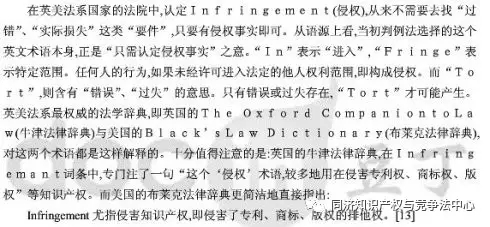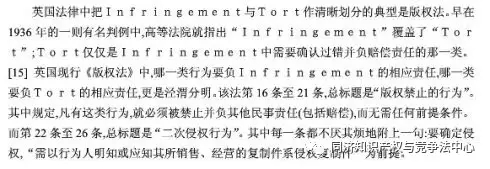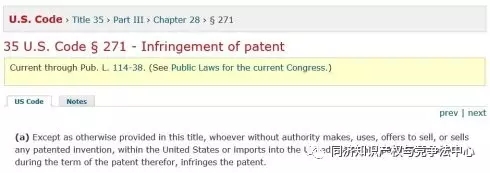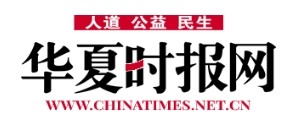
-
 专利
专利 -
 商标
商标 -
 版权
版权 -
 商业秘密
商业秘密 -
 反不正当竞争
反不正当竞争 -
 植物新品种
植物新品种 -
 地理标志
地理标志 -
 集成电路布图设计
集成电路布图设计 -
 技术合同
技术合同 -
 传统文化
传统文化
点击展开全部
律师动态
更多 >>知产速递
更多 >>审判动态
更多 >>案例聚焦
更多 >>法官视点
更多 >>裁判文书
更多 >>
所谓知识产权是专有权,其实是指根据专利法、商标法、外观设计法和著作权(以及邻接权)法等赋予权利人的法定的排他权利(exclusive right),在侵权判定中,只要被告的行为(侵权事实)落入了法定的专有权利的范围,或者说被告实施了未经权利人授权就应该被法律所禁止的行为,就构成侵权,原则上就应该停止侵权并赔偿损失。所以,当有人问我:被告制作了盗版产品但未销售,是否构成“即发侵权”,是否要赔偿损失?我的回答是:无所谓“即发”,因为被告已经侵犯复制权,应该赔偿。这才是“知识产权是专有权”的本质要求。
所谓知识产权是专有权利,只是相对于反不正当竞争保护而言,一部分知识产权所具有的特征,我们并不能把所有的知识产权都概括为是专有权利。甚至连专利、商标、版权这些我们看起来是天经地义的专有权利,其权利的内容也并非仅仅可以用“专有权利”这样的字眼来加以概括的。因此,《民法总则》对知识产权的这个定义大有值得商榷之处。
——————————————————
根据新颁布的《民法总则》第一百二十三条第2款的规定,知识产权是权利人依法就下列客体享有的专有的权利:
(一)作品;
(二)发明、实用新型、外观设计;
(三)商标;
(四)地理标志;
(五)商业秘密;
(六)集成电路布图设计;
(七)植物新品种;
(八)法律规定的其他客体。
那么,如何理解知识产权是专有权? 该款规定的知识产权的客体中,是否全部都享有专有的权利? 本文试对此加以分析。
一、知识产权是专有权的含义及质疑
从林林总总的我国关于知识产权的各类教科书、法律全书以及学术专著对于知识产权的概念、特征的介绍中,我们可以发现,大多数学者都提到了知识产权具有专有性这一法律特征。不管他们对于这种特征的具体含义的理解的差异如何,也不管许多人是否完全是人云亦云,知识产权的专有性特征似乎已经得到多数学者的认同。而知识产权的垄断性也就成了知识产权的专有性这一特征的自然延伸。有的学者甚至于在专有性和垄断性之间直接划了等号:专有性即独占性、排他性或垄断性。[1]民法总则对知识产权的定义,显然是受到了我国IP理论界阐述的知识产权法律特征的影响。
专有权,在英文表述中,应该是指exclusive right。专利权、注册商标权、著作权等法定的知识产权都拥有禁止他人擅自使用其专利技术、文艺作品、商业标识的权利,这个“使用权”[2]就是具有专有权的性质,任何人只要未经许可进入法定的专有权的范围(其实质是法律规定的权利人可以控制他人实施的行为),就构成了侵权行为(infringement),而无须考虑什么主观过错,也无须考虑什么实际损失。正是因为侵权的构成(甚至损害赔偿责任的承担)无需过错和损失的考量,所以,知识产权才被叫做专有权或排他权(exclusive right)。这个无需考虑主观过错的侵权(infringement)区别于另一个我们也称为侵权的,但需要考虑主观过错以及损害后果的tort。郑成思老师对此有清晰的阐述:[3]
即便是大陆法国家,因为存在物权请求权和债权请求权的区分,侵犯专利权、著作权和注册商标权也会产生类似于英美法 infringement 的法律后果和侵权救济。而我国《民法通则》中特殊的“民事责任”规范将停止侵害与赔偿损失的责任方式相提并论,统称“侵权责任”,导致了司法实践中对知识产权侵权责任的构成要件认识混乱,有时完全忽略了知识产权享有“专有权”保护的意义。正因为如此,我国学者提出了“知识产权请求权”的概念,以解释知识产权侵权中存在的特殊问题[4]。所谓知识产权是专有权或者排他权,主要就是从这个意义上去说的。
总之,所谓知识产权是专有权,其实是指根据专利法、商标法、外观设计法和著作权(以及邻接权)法等赋予权利人的法定的排他权利(exclusive right),在侵权判定中,只要被告的行为(侵权事实)落入了法定的专有权利的范围,或者说被告实施了未经权利人授权就应该被法律所禁止的行为,就构成侵权,原则上就应该停止侵权并赔偿损失。
所以,当有人问我:被告制作了盗版产品但未销售,是否构成“即发侵权”,是否要赔偿损失?我的回答是:无所谓“即发”,因为被告已经侵犯复制权,应该赔偿。国内很多学者对于郑成思老师介绍的“即发侵权”概念或主张进行了望文生义的解读,把“即发侵权”理解为即将发生的侵权行为,或者把即发侵权等同于即将销售或许诺销售行为,或者把临时禁令作为是针对即发侵权的救济措施。其实,郑成思老师是从批评“一切侵权的认定均须以已经造成的实际损害为条件,无损害即无责任”的观点出发来阐述“即发侵权”的理论的【参见《郑成思知识产权文集. 国际公约与外国法卷(一)》第61页】。在他看来,根据即发侵权理论,只要被告实施了“制造”专利侵权产品的行为,就可以构成侵权,而无须考虑这个侵权产品是否已经推向市场,即便尚未侵犯销售权,尚未造成什么实际损失,也已经侵犯了专利权。即便非商标权人在库房里面存放了带有商标权人商标瓶贴的酒瓶,而尚未装上假酒,尚未出售以及造成实际损害,按照商标法的规定(擅自制造商标标识),也是侵权行为——这就是TRIPS协议第50条要求成员国所禁止的“即发侵权”,把侵权产品制止在进入流通渠道之前,而不是之后,把侵害制止在“实际损害”发生之前。 【参见《郑成思知识产权文集. 国际公约与外国法卷(一)》第61-3页】。这才是“知识产权是专有权”的本质要求。
但是,即便如此,知识产权与物权并不一样,物权请求权和所谓的知识产权请求权也无法等量齐观。我们依然不能认为:因为“知识产权是专有权”,所以任何对专利权、注册商标权和著作权的侵权行为的救济或执法(enforcement)都无须进行过错的分析。比如,最常见的就是,即便专利权人对于销售专利产品、著作权人对于发行作品的复制件以及注册商标权人对于销售使用其商标的商品享有“排他”的权利,对于销售商的侵权行为,即便其无论是否存在过错都需要停止侵权,但仍需要考虑其是否存在主观过错而豁免损害赔偿责任;而在判定共同侵权以及或教唆、帮助侵权的时候,也必须要考虑侵权者的主观过错。
郑成思老师的《侵权责任、损害赔偿责任与知识产权保护》[5] 一文中对此有着细致的分析:
就英国版权法中的“二次侵权(Secondary infringement)”【我翻译为“继发侵权”】为何需要有过错要件,笔者也曾对此做过一些分析:如果说这种行为是属于对专有权的直接侵犯,那么,理论上,无论侵权人是否存在过错,都构成侵权。既然如此,这里为什么需要增加一个“过错”要件呢? 显然,初始侵权行为和继发侵权行为确实不是属于完全同一性质的侵权行为,尤其是对侵权人的主观过错的要求是不同的。这也许正是英国法把“dealing(商业处置)”侵权复制品的行为专门从一般的直接侵权行为(初始侵权)中分离出来,单独规定“继发侵权”的一个非常合理和合乎逻辑之处。[6]可见,即使我们一般都理所当然地认为著作权中的发行权是作者享有的排他权利或专有权利,但其“排他性”似乎打了很大的折扣。再比如,英国版权法中,对于未经著作权人许可擅自许可他人利用其作品的行为的许可人以及被许可人是否构成侵权,也有特殊的侵权判定规则,对于被许可人(比如出版社的侵权责任)的“侵权行为”也要考虑其主观过错,这就是所谓的“授权侵权(Authorisation of Infringement)”[7]
另外,在知识产权权利人的专有权受到限制的情形——特别是在法定许可的情形,权利人虽然仍然享有报酬请求权,但报酬请求权right to remuneration与排他权exclusive right显然已经不可同日而语了。还有,有的权利本身就仅仅限于报酬请求权,而不是专有权,比如著作权中的“追续权”或再销售权。【参见伯尔尼公约Article 14ter,Right to an interest in resales; (1) The author, or after his death the persons or institutions authorized by national legislation, shall, with respect to original works of art and original manuscripts of writers and composers, enjoy the inalienable right to an interest in any sale of the work subsequent to the first transfer by the author of the work.】再比如,根据WPPT的规定,就表演者和录音制作者而言,对其表演和录音的机械表演或广播行为,也仅仅享有报酬请求权,而并非专有权利【Article 15 Right to Remuneration for Broadcasting and Communication to the Public (1) Performers and producers of phonograms shall enjoy the right to a single equitable remuneration for the direct or indirect use of phonograms published for commercial purposes for broadcasting or for any communication to the public.】
还有,基于知识产权作为财产权而具有的排他性,法经济学者(law and economics scholars)把因侵犯知识产权而予以禁令救济(injunctive relief)的规则称为“财产规则(property rule)”,而允许按照法院或者某个机构设定的价格来获取知识产权的规则(比如,强制许可)被称为“责任规则(liability rules)”[8]在知识产权侵权救济中,适用“财产规则”还是适用“责任规则”也越来越受到学界的关注。[9]我国有学者认为:人们通常将知识产权视为一种排他权,并将排他权和禁令保护划等号。其中专利权表现得最为明显。有法院甚至认为,既然专利法规定“专利权人有权排除他人使用、许诺销售、销售有关发明”,那么永久禁令是原告的法定权利,原则上不属于法院根据衡平原则的自由裁量范围。这种观点曲解了排他性的本质,著作权、专利权、商标权并非一种绝对权,权利人享有停止侵害的请求权,而是否颁发停止侵害的禁令,则是法院的自由裁量权。由于财产权与禁令的关系非常密切,以至于法经济学者将禁令救济称为“财产规则”(property rules)。法院在知识产权侵权中也根据“财产规则”广泛采用停止侵害措施。然而,这种类比和借用忽略了知识产权特殊的权利属性,并对权利执行带来不合意的结果。[10]可见,从禁令救济的角度来看,即便说知识产权是专有权或者排他权,也并非那么绝对。这样的观点,其实郑成思老师也早已经从“物权请求权”转化为“债权请求权”或者说从物权之诉和债权之诉相互替换的角度进行过全面的分析【参见《郑成思知识产权文集. 基本理论卷》第274-275页】。
二、不享有专有权的知识产权客体
至于大家一般认同的受知识产权(IP)保护的客体——如《民法总则》所列举的知识产权客体中,是否全部客体都享有专有权或排他权?则更值得商榷。
1.商业秘密
商业秘密虽然已经从依靠“保密协议”的债权保护转化为法定的保护,有了“财产权”或者说“对世权”的特点, [11]
但笔者以为对商业秘密所有人的侵权判定仍然不同于对专利权、商标权和著作权的侵权。首先,商业秘密不同于发明,发明专利实行一发明一专利的原则,因此,专利权是绝对排他的,而理论上,同样的商业秘密是可以由两个以上主体各自享有的,因此各自并不享有排他的专有权利。其次,大多数国家(包括我国)对商业秘密的保护仍然置于“反不正当竞争法”的框架下,对擅自窃取或披露商业行为等行为的侵权判定仍然要考察是否属于违背商业伦理的不正当竞争行为,因此主观过错和损害后果仍然在商业秘密侵权判定要加以权衡的重要因素。
2. 商标:驰名商标。
虽然驰名商标的保护已经在国际公约和各国商标法中都有了明确规定,但是,与注册商标权劝人享有的专有权利不同(特别是在“双相同”的情形下),对驰名商标的保护(即便是对注册的驰名商标的保护)还是基于一种反不正当竞争的理念,必须考虑商标已经具有的知名度和商誉,必须考虑侵权行为对商标权人造成的损害——混淆可能、利用商誉、商誉贬损和显著性的淡化等。
3. 地理标志
虽然地理标志在取得商标注册后,可以享有注册商标专有权利,但是这其实只是注册商标的保护问题,而与地理标志本身的保护无关。对于未注册的地理标志的保护,恐怕仍然得回到反不正当竞争法的框架下来考量,在侵权判定中应该考虑被告使用地理标志名称的正当性与否。TRIPS第22条第2款规定:就地理标识而言,各成员应向利害关系方提供法律手段以防止:(a)在一货物的标志或说明中使用任何手段标明或暗示所涉货物来源于真实原产地之外的一地理区域,从而在该货物的地理来源方面使公众产生误解;(b)构成属《巴黎公约》(1967)第10条之二范围内的不公平竞争行为的任何使用。
4. 其他客体: 商号/字号
商号/字号是独立于商标的知识产权保护客体。商号的保护,与该商号是否已经登记为企业名称无关。无论企业名称注册登记与否,一个商号只要通过使用享有了知名度或声誉,就应该获得反不正当竞争的保护,当然这种保护仍然是基于不正当竞争法,而不是一个排他的专有权。
5. 其他客体:知名商品特有名称包装装潢以及禁止其他利用他人无形成果的不正当竞争
从英国法中的禁止仿冒(passing off)与法国法中的侵权损害赔偿责任衍生而来的反不正当竞争,与专利、商标、版权、外观设计等作为“专有权利”的知识产权之间存在着天然的联系。可以说,反不正当竞争法所禁止的两方面行为:Misrepresentation(虚假陈述) & Misappropriation(非法盗用)也是知识产权法所禁止。前者是把自己的东西说成是别人的【俗称:搭便车】,包括:假冒商标、假冒企业名称、假冒名人姓名,假冒作者署名,假冒他人专利(标识),假冒他人作品名称,以及虚假宣传广告和商标反向假冒;后者是把别人的东西当成是自己的【俗称:不劳而获】,包括:窃取他人创意或商业秘密,盗用他人数据信息,盗用他人技术发明,抄袭他人外观设计,剽窃他人作品。盗用行为,多数是暗偷——如抄袭或剽窃 ;有时是明抢——如赤裸裸的翻印盗版和擅自传播。反法的这两个主线——假冒和盗用,前者,更多地走向了商标法;后者,更多地走向了专利法;著作权法和外观设计法,则游离在两者之间。
而反法的最大功能是:当立法没有办法及时或者很好地把需要提供知识产权保护的客体通过“专有权利”来保护的时候,就可以发挥反法的“兜底”作用来加以保护。因此,如果说知识产权法与反法有区别的话,无非是:一个“专有权利”,而一个仍然保留传统侵权救济的基本要求:试图混淆或盗用他人的无形成果者者存在主观过错,以及这样的行为会造成对竞争的不良损害后果。如果我们还承认反不正当竞争法是知识产权法的重要组成部分,制止不正当竞争也是一项知识产权的话,那么,我们就不应该轻易地下这样的结论:知识产权是专有权利。
总之,所谓知识产权是专有权利,只是相对于反不正当竞争保护而言,一部分知识产权所具有的特征,我们并不能把所有的知识产权都概括为是专有权利。甚至连专利、商标、版权这些我们看起来是天经地义的专有权利,其权利的内容也并非仅仅可以用“专有权利”这样的字眼来加以概括的。因此,《民法总则》对知识产权的这个定义大有值得商榷之处。
三、享有专有权利的知识产权客体 以下是有关专有权利的规定:
(一)作品
就作品享有的著作权中的财产权而言,国际公约中也明确是规定为“专有权利”的。
比如,伯尔尼公约中,著作权人享有的专有权利包括:
汇编权:The author shall enjoy the exclusive right of making a collection of his works mentioned in the preceding paragraphs.
翻译权:Authors of literary and artistic works protected by this Convention shall enjoy the exclusive right of making and of authorizing the translation of their works through out the term of protection of their rights in the original works.
复制权:Authors of literary and artistic works protected by this Convention shall have the exclusive right of authorizing the reproduction of these works, in any manner or form.
表演权:Authors of dramatic, dramatico-musical and musical works shall enjoy the exclusive right of authorizing the public performance of their works, including such public performance by any means or process.
广播权:Authors of literary and artistic works shall enjoy the exclusive right of authorizing the broadcasting of their works or the communication thereof to the public by any other means of wireless diffusion of signs, sounds or images;
改编权:Authors of literary or artistic works shall enjoy the exclusive right of authorizing adaptations, arrangements and other alterations of their works.
摄制权:Authors of literary or artistic works shall have the exclusive right of authorizing the cinematographic adaptation and reproduction of these works, and the distribution of the works thus adapted or reproduced;
再比如,在WCT中,著作权人享有的专有权利包括:
发行权:Authors of literary and artistic works shall enjoy the exclusive right of authorizing the making available to the public of the original and copies of their works through sale or other transfer of ownership.
出租权:Authors of (i) computer programs; (ii) cinematographic works; and (iii) works embodied in phonograms, as determined in the national law of Contracting Parties, shall enjoy the exclusive right of authorizing commercial rental to the public of the originals or copies of their works.
向公众传播权(包括信息网络传播权/向公众提供权):Authors of literary and artistic works shall enjoy the exclusive right of authorizing any communication to the public of their works, by wire or wireless means, including the making available to the public of their works in such a way that members of the public may access these works from a place and at a time individually chosen by them。
但是,就著作权人享有的精神权利是否为专有权利,笔者也表示怀疑。《伯尔尼公约》在关于经济权利的表述中使用了“exclusive right”而在关于精神权利的表述中,没有使用“exclusive right”【the author shall have the right to claim authorship of the work and to object to any distortion, mutilation or other modification of, or other derogatory action in relation to, the said work, which would be prejudicial to his honor or reputation.】,这是为什么呢?笔者以为,与著作权中的经济权利(“exclusive right”)更多体现为排除或禁止他人使用其作品的权利不同,法律赋予作者的精神权利确实不见得是为了实现这个“禁止”功能,比如,法律规定作者享有署名权,很大程度上是为了保护作者“行使”表明自己身份的权利【虽然著作权法第47条第三项也规定“禁止”非作者在他人创作的作品上署名,但这个“禁止他人署名的权利”并不是“要求署名的权利”的反面,这与经济权利作为排他权具有正反两面——比如,复制权意味着“有权(许可)复制”与“有权禁止复制”,是不相同的。从这个意义上说,署名权确实不是专有权或者排他权。】;而法律规定作者享有修改权,目的也在于保障作者可以自由修改自己的作品(至于,有没有必要或者应不应该赋予这个权利,可以另论。)这也许是《伯尔尼公约》在规定“moral right”时没有使用“exclusive right”的一个原因。[12]
(二)发明
虽然我们一般都认为专利权人享有“制造、使用、销售、许诺销售和进口”等数项“专有权利”,但各国专利法文本中,将这些权利表述为专有权利(exclusive right)的比较少见,而更多地将其表述为“禁止权”而不是“许可权”。我国专利法的表述与德国专利法类似(不得/禁止):
德国专利法第九条:Section 9
The patent shall have the effect that the proprietor of the patent alone shall be entitled to use the patented invention within the scope of the law in force. In the absence of the consent of the proprietor of the patent, any third party shall be prohibited from
producing, offering, putting on the market or using a product which is the subject-matter of the patent, or from either importing or possessing such a product for the purposes referred to;
using a process which is the subject-matter of the patent or, if the third party knows or if it is obvious from the circumstances that use of the process is prohibited in the absence of the consent of the proprietor of the patent, from offering the process for use within the territorial scope of this Act;
offering, placing on the market or using a product which is produced directly by a process which is the subject-matter of the patent, or from either importing or possessing such a product for the purposes referred to.
美国英国和专利法则是从何谓侵权行为的角度来规定专利权人的专有权利的:
美国法典:
英国1977专利法(2014年修改)
但是TRIPS协议第28条关于“授予的权利”则明确称之为“专有权利”
1. 一专利授予其所有权人下列专有权利:
(a)如一专利的客体是产品,则防止第三方未经所有权人同意而进行制造、使用、标价出售、销售或为这些目的而进口该产品的行为;
(b)如一专利的客体是方法,则防止第三方未经所有权人同意而使用该方法的行为,并防止使用、标价出售、销售或为这些目的而进口至少是以该方法直接获得产品的行为。
(三)外观设计
我国外观设计专利权也是用“禁止”他人实施的行为来表述权利人享有的专有权利的。TRIPS协议Article 26也使用了“有权禁止”的表述:1. The owner of a protected industrial design shall have the right to prevent third parties not having the owner’s consent from making, selling or importing articles bearing or embodying a design which is a copy, or substantially a copy, of the protected design, when such acts are undertaken for commercial purposes.
但欧盟外观设计指令则明确地使用了“专有权利”的表述:
Directive 98/71/EC of the European Parliament and of the Council of 13 October 1998 on the legal protection of designs
Official Journal L 289 , 28/10/1998 P. 0028 - 0035
Article 12
Rights conferred by the design right
1.The registration of a design shall confer on its holder the exclusive right to use it and to prevent any third party not having his consent from using it. The aforementioned use shall cover, in particular, the making, offering, putting on the market, importing, exporting or using of a product in which the design is incorporated or to which it is applied, or stocking such a product for those purposes.
(四)注册商标
我国《商标法》是从构成侵权行为的角度,用两个条文来实现对注册商标专利权的范围的规定的。
第五十七条 有下列行为之一的,均属侵犯注册商标专用权:
(一)未经商标注册人的许可,在同一种商品上使用与其注册商标相同的商标的;
(二)未经商标注册人的许可,在同一种商品上使用与其注册商标近似的商标,或者在类似商品上使用与其注册商标相同或者近似的商标,容易导致混淆的;
(三)销售侵犯注册商标专用权的商品的;
(四)伪造、擅自制造他人注册商标标识或者销售伪造、擅自制造的注册商标标识的;
……
(六)故意为侵犯注册商标专用权提供便利条件……【根据实施条例第75条,包括提供仓储】
(七)给他人的注册商标专用权造成其他损害的。【根据法释(2003)23号解释第1条,包括将注册商标作为企业字号在相同或类似商品上突出使用】
第四十八条 本法所称商标的使用,是指将商标用于商品、商品包装或者容器以及商品交易文书上,或者将商标用于广告宣传、展览以及其他商业活动中,用于识别商品来源的行为。
比较而言,德国商标法则明确指出了注册商标的“专有权利”,其逻辑更为清晰:把商标相同或近似的判定【section 14 (2)】与商标专用权的范围【关于商标使用行为的列举,section 14(3)】分为两个层面的规则:
Section 14
Exclusive right of the proprietor of a trade mark
(1) The acquisition of trade mark protection in accordance with section 4 shall grant to the proprietor of the trade mark an exclusive right.
(2) A third party shall be prohibited, without the consent of the proprietor of the trade mark in the course of trade, from
using a sign which is identical to the trade mark for goods or services which are identical to those for which it enjoys protection,…….(双相同)
(3) If the prerequisites of subs. 2 are met, it shall in particular be prohibited
to affix the sign to goods or their wrappings or packaging,(用于商品或包装)
to offer or provide services under the sign,(以该标识提供服务)
to import or export goods under the sign,(商品进出口)
to use the sign in business papers or in advertising.(商业文书或广告)
(4) Third parties shall be furthermore prohibited without the authorisation of the proprietor of the trade mark in the course of trade
to affix a sign that is identical to thetrade mark or a similar sign on wrappings or packaging or on means of identification such as labels, tags, badges or the like,
to offer, put on the market or stock for the listed purposes wrappings, packaging or means of identification which bear a sign that is identical to the trade mark or to a similar sign, or
to import or export wrappings, packaging or means of identification which bear a sign that is identical to the trade mark or to a similar sign
if the danger exists that the wrappings or packaging are used to wrap or package, or that the means of identification are used to identify goods or services with regard to which third parties would be prohibited from using the sign in accordance with subs. 2 and 3.(制作包装或标识)
2015新修改的欧盟商标指令也有类似的规定:
DIRECTIVE (EU) 2015/2436 OF THE EUROPEAN PARLIAMENT AND OF THE COUNCIL of 16 December 2015 to approximate the laws of the Member States relating to trade marks
Article 10
Rights conferred by a trade mark
The registration of a trade mark shall confer on the proprietor exclusive rights therein.
Without prejudice to the rights of proprietors acquired before the filing date or the priority date of the registered trade mark, the proprietor of that registered trade mark shall be entitled to prevent all third parties not having his consent from using in the course of trade, in relation to goods or services, any sign where:
(a) the sign is identical with the trade mark and is used in relation to goods or services which are identical with those for which the trade mark is registered;……
The following, in particular, may be prohibited under paragraph 2:
(a) affixing the sign to the goods or to the packaging thereof;
(b) offering the goods or putting them on the market, or stocking them for those purposes, under the sign, or offering or supplying services the reunder;
(c) importing or exporting the goods under the sign;
(d) using the sign as a trade or company name or part of a trade or company name;[将注册商标用作商号]
(e) using the sign on business papers and in advertising;
(f) using the sign in comparative advertising in a manner that is contrary to Directive 2006/114/EC.【比较广告中的使用】
需要指出的是:无论是德国法,还是欧盟新的指令,并没有“用于识别商品来源的行为”的规定。
(五)集成电路布图设计
对于集成电路布图设计享有的专有权利,TRIPS协议的表述是“下列行为违法”:Article 36 Scope of the Protection
Subject to the provisions of paragraph 1 of Article 37, Members shall consider unlawful the following acts if performed without the authorization of the right holder: importing, selling, or otherwise distributing for commercial purposes a protected layout-design, an integrated circuit in which a protected layout-design is incorporated, or an article incorporating such an integrated circuit only in so far as it continues to contain an unlawfully reproduced layout-design.
(六)植物新品种
对于植物新品种享有的专有权利,《保护植物新品种国际公约》第14条规定了品种权的范围(1)[与繁殖材料有关的活动](a)依照第15和16条,涉及受保护品种繁殖材料的下列活动需育种家授权:(i)生产或繁殖;(ii)为繁殖而进行的调整;(iii)提供销售;(iv)销售或其它交易;(v)出口;(vi)进口;(vii)出于上述(i)至(vi)的目的而提供存货。而我国《植物新品种保护条例》第六条则使用了“排他的独占权”的表述:完成育种的单位或者个人对其授权品种,享有排他的独占权。任何单位或者个人未经品种权所有人(以下称品种权人)许可,不得为商业目的生产或者销售该授权品种的繁殖材料,不得为商业目的将该授权品种的繁殖材料重复使用于生产另一品种的繁殖材料;但是,本条例另有规定的除外。
(七)其他客体:表演、录音和广播节目信号表演者就其表演,录音(首次)制作者就其制作的录音制品以及广播电视台就其播出的节目信号享有独立于著作权的邻接权保护。因此,表演、录音制品和广播节目信号也是受知识产权保护的客体,可以列为《民法总则》所说的“法律规定的其他客体”。而且,这些邻接权也可以称之为“专有权利”。
根据《罗马公约》第7条的规定,表演者可以享有的专有权利(禁止权)是:
Article 7 [Minimum Protection for Performer]
1.The protection provided for performers by this Convention shall include the possibility of preventing:
(a) the broadcasting and the communication to the public, without their consent, of their performance, except where the performance used in the broadcasting or the public communication is itself already a broadcast performance or is made from a fixation;
(b) the fixation, without their consent, of their unfixed performance;
(c) the reproduction, without their consent, of a fixation of their performance:……..
根据WPPT,表演者明确享有各项“专有权利”:
Article 6 Economic Rights of Performers in their Unfixed Performances
Performers shall enjoy the exclusive right of authorizing, as regards their performances:
(i) the broadcasting and communication to the public of their unfixed performances except where the performance is already a broadcast performance; and
(ii) the fixation of their unfixed performances.
Article 7 Right of Reproduction
Performers shall enjoy the exclusive right of authorizing the direct or indirect reproduction of their performances fixed in phonograms, in any manner or form.6
Article 8 Right of Distribution
(1) Performers shall enjoy the exclusive right of authorizing the making available to the public of the original and copies of their performances fixed in phonograms through sale or other transfer of ownership.
Article 9 Right of Rental
(1) Performers shall enjoy the exclusive right of authorizing the commercial rental to the public of the original and copies of their performances fixed in phonograms as determined in the national law of Contracting Parties, even after distribution of them by, or pursuant to, authorization by the performer.
Article 10 Right of Making Available of Fixed Performances
Performers shall enjoy the exclusive right of authorizing the making available to the public of their performances fixed in phonograms, by wire or wireless means, in such a way that members of the public may access them from a place and at a time individually chosen by them.
根据《罗马公约》第10条的规定,录音制作者者可以享有的专有权利是:
Article 10 [Right of Reproduction for Phonogram Producers]
Producers of phonograms shall enjoy the right to authorize or prohibit the direct or indirect reproduction of their phonograms.
根据WPPT,录音制作者明确享有各项“专有权利”:
Article 11 Right of Reproduction
Producers of phonograms shall enjoy the exclusive right of authorizing the direct or indirect reproduction of their phonograms, in any manner or form.9
Article 12 Right of Distribution
(1) Producers of phonograms shall enjoy the exclusive right of authorizing the making available to the public of the original and copies of their phonograms through sale or other transfer of ownership.
Article 14 Right of Making Available of Phonograms
Producers of phonograms shall enjoy the exclusive right of authorizing the making available to the public of their phonograms, by wire or wireless means, in such a way that members of the public may access them from a place and at a time individually chosen by them.
根据《罗马公约》第13条的规定,广播组织可以享有的专有权利是:
Article 13 [Minimum Rights for Broadcasting Organizations]
Broadcasting organisations shall enjoy the right to authorize or prohibit:
(a) the rebroadcasting of their broadcasts;
(b) the fixation of their broadcasts;
(c) the reproduction: (i) of fixations, made without their consent, of their broadcasts; (ii) of fixations, made in accordance with the provisions of Article 15, of their broadcasts, if the reproduction is made for purposes different from those referred to in those provisions;
(d) the communication to the public of their television broadcasts if such communication is made in places accessible to the public against payment of an entrance fee; it shall be a matter for the domestic law of the State where protection of this right is claimed to determine the conditions under which it may be exercised.
可见,在不同的知识产权中,对专有权利的表述也不尽相同,有的明确使用了专有权或排他权或独占权的表述,有的则以“未经许可,不得或禁止……”来表达,有的用“未经授权的……..行为违法”来描述,有的还以“下列行为…需获得授权”来体现。这些不同的表述,是否还隐藏着不同的法律含义,还有待于进一步考察。
[1]张伟君:知识产权的垄断性辨析(1):垄断性不是知识产权的特征,http://blog.sina.cn/dpool/blog/s/blog_4da63f4101018xs7.html?vt=4。
[2]关于使用权的含义,参见张伟君:知识产权产品使用者侵权责任之解析,发表于《中国知识产权》2017年6月号第124期,网址:http://www.ciplawyer.cn/articleview/article_view_22283.htm
[3]郑成思:《侵权责任、损害赔偿责任与知识产权保护》,载于《环球法律评论》2003年第4期,http://www.docin.com/p-525596029.html。
[4] 王太平:浅论知识产权请求权,1998年,http://article.chinalawinfo.com/ArticleHtml/Article_34035.shtml。胡志强:中德知识产权请求权制度比较,《科技与法律》2000年第03期。蒋志培: 我国立法和司法确认的知识产权请求权,《中国律师》2001年第10期。陈锦川:试论我国知识产权请求权的初步确立,《人民司法》2002年第10期。徐卓斌:知识产权请求权与损害赔偿请求权的区分,2013-02-21,来源:人民法院报,http://fayuan.xinmin.cn/mtjj/2013/02/21/18750960.html。但也有学者对“知识产权请求权”提出质疑,参见:梁志文:反思知识产权请求权理论——知识产权要挟策略与知识产权请求权的限制,《清华法学》2008年第04期;李扬; 知识产权请求权的限制,《法商研究》2010年第04期。
[5]郑成思:《侵权责任、损害赔偿责任与知识产权保护》,载于《环球法律评论》2003年第4期,http://www.docin.com/p-525596029.html。
[6] 张伟君:英国版权法为什么要区分Primary Infringement 和Secondary Infringement,http://blog.sina.cn/dpool/blog/s/blog_4da63f410101jk50.html?vt=4。
[7] 张伟君:英国版权法中的第三方侵权责任:授权侵权(Authorisation of Infringement)及其它,http://blog.sina.cn/dpool/blog/s/blog_4da63f410101jlu7.html?vt=4。
[8] Mark Lemley& Phil Weiser: Should Property or Liability Rules Govern Information? Texas Law Review Volume 85, Number 4, March 2007 : http://ssrn.com/abstract=977778。
[9] When a patent has been infringed, the court can impose a forward-looking remedy based on a property rule or based on a liability rule. Under the property rule, the court issues an injunction ordering the infringing party to stop infringing. Under the liability rule, the court allows the infringing party to continue to infringe the patent in question so long as it pays specified ongoing royalties to the patent holder. 参见:Carl Shapiro:Property Rules vs. Liability Rules for Patent Infringement,10 January 2017,http://faculty.haas.berkeley.edu/shapiro/propvsliab.pdf,
[10] 陈武:权利不确定性与知识产权停止侵害请求权之限制,《中外法学》2011年第2期。另有学者指出:
无条件启动物权保全请求权或发布禁令以阻止对财产权的侵害,是大陆法系和英美法系的共同原则。但如果更细致观察就会发现,这种规则的描述其实相当空泛且具有误导性的。事实上,作为物权保全请求权(或禁令)基础的妨害概念的外延异常模糊,与损害常常发生混淆。而且,晚近的司法判例表明即便构成了妨害,物权保全请求权(或禁令)也不是理所当然被适用。绝对的个人所有权观念被无情地颠覆,代之以社会所有权的思想。这种变化,折射出20世纪以来法哲学风向的转变。法经济学大师卡拉布雷西将财产权的保护方法划分为财产规则与责任规则两种基本类型,以成本效益为标准考察每种保护规则的适用范围与适用限度,责任规则允许资源从受害人向侵害人移转而不用经过受害人的同意,而财产权利以及它的赔偿履行要求经过受害人对这种转移的同意,因此任何人占有属于别人的物品的行为都是被禁止的,即使他能够证明该物对于他的价值甚至大于物品所有人。参见杨彪:非损害赔偿侵权责任方式的法理与实践,《法制与社会发展》2011年第3期http://study.ccln.gov.cn/fenke/faxue/fxjpwz/fxmssfx/195205-1.shtml。
[11]郑成思:《侵权责任、损害赔偿责任与知识产权保护》,载于《环球法律评论》2003年第4期,http://www.docin.com/p-525596029.html。
[12]张伟君:关于保护作品完整权、修改权和撤回权:对一些观点的商榷,http://blog.sina.cn/dpool/blog/s/blog_4da63f410101i08c.html?vt=4。
所谓知识产权是专有权利,只是相对于反不正当竞争保护而言,一部分知识产权所具有的特征,我们并不能把所有的知识产权都概括为是专有权利。甚至连专利、商标、版权这些我们看起来是天经地义的专有权利,其权利的内容也并非仅仅可以用“专有权利”这样的字眼来加以概括的。因此,《民法总则》对知识产权的这个定义大有值得商榷之处。
——————————————————
根据新颁布的《民法总则》第一百二十三条第2款的规定,知识产权是权利人依法就下列客体享有的专有的权利:
(一)作品;
(二)发明、实用新型、外观设计;
(三)商标;
(四)地理标志;
(五)商业秘密;
(六)集成电路布图设计;
(七)植物新品种;
(八)法律规定的其他客体。
那么,如何理解知识产权是专有权? 该款规定的知识产权的客体中,是否全部都享有专有的权利? 本文试对此加以分析。
一、知识产权是专有权的含义及质疑
从林林总总的我国关于知识产权的各类教科书、法律全书以及学术专著对于知识产权的概念、特征的介绍中,我们可以发现,大多数学者都提到了知识产权具有专有性这一法律特征。不管他们对于这种特征的具体含义的理解的差异如何,也不管许多人是否完全是人云亦云,知识产权的专有性特征似乎已经得到多数学者的认同。而知识产权的垄断性也就成了知识产权的专有性这一特征的自然延伸。有的学者甚至于在专有性和垄断性之间直接划了等号:专有性即独占性、排他性或垄断性。[1]民法总则对知识产权的定义,显然是受到了我国IP理论界阐述的知识产权法律特征的影响。
专有权,在英文表述中,应该是指exclusive right。专利权、注册商标权、著作权等法定的知识产权都拥有禁止他人擅自使用其专利技术、文艺作品、商业标识的权利,这个“使用权”[2]就是具有专有权的性质,任何人只要未经许可进入法定的专有权的范围(其实质是法律规定的权利人可以控制他人实施的行为),就构成了侵权行为(infringement),而无须考虑什么主观过错,也无须考虑什么实际损失。正是因为侵权的构成(甚至损害赔偿责任的承担)无需过错和损失的考量,所以,知识产权才被叫做专有权或排他权(exclusive right)。这个无需考虑主观过错的侵权(infringement)区别于另一个我们也称为侵权的,但需要考虑主观过错以及损害后果的tort。郑成思老师对此有清晰的阐述:[3]

即便是大陆法国家,因为存在物权请求权和债权请求权的区分,侵犯专利权、著作权和注册商标权也会产生类似于英美法 infringement 的法律后果和侵权救济。而我国《民法通则》中特殊的“民事责任”规范将停止侵害与赔偿损失的责任方式相提并论,统称“侵权责任”,导致了司法实践中对知识产权侵权责任的构成要件认识混乱,有时完全忽略了知识产权享有“专有权”保护的意义。正因为如此,我国学者提出了“知识产权请求权”的概念,以解释知识产权侵权中存在的特殊问题[4]。所谓知识产权是专有权或者排他权,主要就是从这个意义上去说的。
总之,所谓知识产权是专有权,其实是指根据专利法、商标法、外观设计法和著作权(以及邻接权)法等赋予权利人的法定的排他权利(exclusive right),在侵权判定中,只要被告的行为(侵权事实)落入了法定的专有权利的范围,或者说被告实施了未经权利人授权就应该被法律所禁止的行为,就构成侵权,原则上就应该停止侵权并赔偿损失。
所以,当有人问我:被告制作了盗版产品但未销售,是否构成“即发侵权”,是否要赔偿损失?我的回答是:无所谓“即发”,因为被告已经侵犯复制权,应该赔偿。国内很多学者对于郑成思老师介绍的“即发侵权”概念或主张进行了望文生义的解读,把“即发侵权”理解为即将发生的侵权行为,或者把即发侵权等同于即将销售或许诺销售行为,或者把临时禁令作为是针对即发侵权的救济措施。其实,郑成思老师是从批评“一切侵权的认定均须以已经造成的实际损害为条件,无损害即无责任”的观点出发来阐述“即发侵权”的理论的【参见《郑成思知识产权文集. 国际公约与外国法卷(一)》第61页】。在他看来,根据即发侵权理论,只要被告实施了“制造”专利侵权产品的行为,就可以构成侵权,而无须考虑这个侵权产品是否已经推向市场,即便尚未侵犯销售权,尚未造成什么实际损失,也已经侵犯了专利权。即便非商标权人在库房里面存放了带有商标权人商标瓶贴的酒瓶,而尚未装上假酒,尚未出售以及造成实际损害,按照商标法的规定(擅自制造商标标识),也是侵权行为——这就是TRIPS协议第50条要求成员国所禁止的“即发侵权”,把侵权产品制止在进入流通渠道之前,而不是之后,把侵害制止在“实际损害”发生之前。 【参见《郑成思知识产权文集. 国际公约与外国法卷(一)》第61-3页】。这才是“知识产权是专有权”的本质要求。
但是,即便如此,知识产权与物权并不一样,物权请求权和所谓的知识产权请求权也无法等量齐观。我们依然不能认为:因为“知识产权是专有权”,所以任何对专利权、注册商标权和著作权的侵权行为的救济或执法(enforcement)都无须进行过错的分析。比如,最常见的就是,即便专利权人对于销售专利产品、著作权人对于发行作品的复制件以及注册商标权人对于销售使用其商标的商品享有“排他”的权利,对于销售商的侵权行为,即便其无论是否存在过错都需要停止侵权,但仍需要考虑其是否存在主观过错而豁免损害赔偿责任;而在判定共同侵权以及或教唆、帮助侵权的时候,也必须要考虑侵权者的主观过错。
郑成思老师的《侵权责任、损害赔偿责任与知识产权保护》[5] 一文中对此有着细致的分析:

就英国版权法中的“二次侵权(Secondary infringement)”【我翻译为“继发侵权”】为何需要有过错要件,笔者也曾对此做过一些分析:如果说这种行为是属于对专有权的直接侵犯,那么,理论上,无论侵权人是否存在过错,都构成侵权。既然如此,这里为什么需要增加一个“过错”要件呢? 显然,初始侵权行为和继发侵权行为确实不是属于完全同一性质的侵权行为,尤其是对侵权人的主观过错的要求是不同的。这也许正是英国法把“dealing(商业处置)”侵权复制品的行为专门从一般的直接侵权行为(初始侵权)中分离出来,单独规定“继发侵权”的一个非常合理和合乎逻辑之处。[6]可见,即使我们一般都理所当然地认为著作权中的发行权是作者享有的排他权利或专有权利,但其“排他性”似乎打了很大的折扣。再比如,英国版权法中,对于未经著作权人许可擅自许可他人利用其作品的行为的许可人以及被许可人是否构成侵权,也有特殊的侵权判定规则,对于被许可人(比如出版社的侵权责任)的“侵权行为”也要考虑其主观过错,这就是所谓的“授权侵权(Authorisation of Infringement)”[7]
另外,在知识产权权利人的专有权受到限制的情形——特别是在法定许可的情形,权利人虽然仍然享有报酬请求权,但报酬请求权right to remuneration与排他权exclusive right显然已经不可同日而语了。还有,有的权利本身就仅仅限于报酬请求权,而不是专有权,比如著作权中的“追续权”或再销售权。【参见伯尔尼公约Article 14ter,Right to an interest in resales; (1) The author, or after his death the persons or institutions authorized by national legislation, shall, with respect to original works of art and original manuscripts of writers and composers, enjoy the inalienable right to an interest in any sale of the work subsequent to the first transfer by the author of the work.】再比如,根据WPPT的规定,就表演者和录音制作者而言,对其表演和录音的机械表演或广播行为,也仅仅享有报酬请求权,而并非专有权利【Article 15 Right to Remuneration for Broadcasting and Communication to the Public (1) Performers and producers of phonograms shall enjoy the right to a single equitable remuneration for the direct or indirect use of phonograms published for commercial purposes for broadcasting or for any communication to the public.】
还有,基于知识产权作为财产权而具有的排他性,法经济学者(law and economics scholars)把因侵犯知识产权而予以禁令救济(injunctive relief)的规则称为“财产规则(property rule)”,而允许按照法院或者某个机构设定的价格来获取知识产权的规则(比如,强制许可)被称为“责任规则(liability rules)”[8]在知识产权侵权救济中,适用“财产规则”还是适用“责任规则”也越来越受到学界的关注。[9]我国有学者认为:人们通常将知识产权视为一种排他权,并将排他权和禁令保护划等号。其中专利权表现得最为明显。有法院甚至认为,既然专利法规定“专利权人有权排除他人使用、许诺销售、销售有关发明”,那么永久禁令是原告的法定权利,原则上不属于法院根据衡平原则的自由裁量范围。这种观点曲解了排他性的本质,著作权、专利权、商标权并非一种绝对权,权利人享有停止侵害的请求权,而是否颁发停止侵害的禁令,则是法院的自由裁量权。由于财产权与禁令的关系非常密切,以至于法经济学者将禁令救济称为“财产规则”(property rules)。法院在知识产权侵权中也根据“财产规则”广泛采用停止侵害措施。然而,这种类比和借用忽略了知识产权特殊的权利属性,并对权利执行带来不合意的结果。[10]可见,从禁令救济的角度来看,即便说知识产权是专有权或者排他权,也并非那么绝对。这样的观点,其实郑成思老师也早已经从“物权请求权”转化为“债权请求权”或者说从物权之诉和债权之诉相互替换的角度进行过全面的分析【参见《郑成思知识产权文集. 基本理论卷》第274-275页】。
二、不享有专有权的知识产权客体
至于大家一般认同的受知识产权(IP)保护的客体——如《民法总则》所列举的知识产权客体中,是否全部客体都享有专有权或排他权?则更值得商榷。
1.商业秘密
商业秘密虽然已经从依靠“保密协议”的债权保护转化为法定的保护,有了“财产权”或者说“对世权”的特点, [11]
但笔者以为对商业秘密所有人的侵权判定仍然不同于对专利权、商标权和著作权的侵权。首先,商业秘密不同于发明,发明专利实行一发明一专利的原则,因此,专利权是绝对排他的,而理论上,同样的商业秘密是可以由两个以上主体各自享有的,因此各自并不享有排他的专有权利。其次,大多数国家(包括我国)对商业秘密的保护仍然置于“反不正当竞争法”的框架下,对擅自窃取或披露商业行为等行为的侵权判定仍然要考察是否属于违背商业伦理的不正当竞争行为,因此主观过错和损害后果仍然在商业秘密侵权判定要加以权衡的重要因素。
2. 商标:驰名商标。
虽然驰名商标的保护已经在国际公约和各国商标法中都有了明确规定,但是,与注册商标权劝人享有的专有权利不同(特别是在“双相同”的情形下),对驰名商标的保护(即便是对注册的驰名商标的保护)还是基于一种反不正当竞争的理念,必须考虑商标已经具有的知名度和商誉,必须考虑侵权行为对商标权人造成的损害——混淆可能、利用商誉、商誉贬损和显著性的淡化等。
3. 地理标志
虽然地理标志在取得商标注册后,可以享有注册商标专有权利,但是这其实只是注册商标的保护问题,而与地理标志本身的保护无关。对于未注册的地理标志的保护,恐怕仍然得回到反不正当竞争法的框架下来考量,在侵权判定中应该考虑被告使用地理标志名称的正当性与否。TRIPS第22条第2款规定:就地理标识而言,各成员应向利害关系方提供法律手段以防止:(a)在一货物的标志或说明中使用任何手段标明或暗示所涉货物来源于真实原产地之外的一地理区域,从而在该货物的地理来源方面使公众产生误解;(b)构成属《巴黎公约》(1967)第10条之二范围内的不公平竞争行为的任何使用。
4. 其他客体: 商号/字号
商号/字号是独立于商标的知识产权保护客体。商号的保护,与该商号是否已经登记为企业名称无关。无论企业名称注册登记与否,一个商号只要通过使用享有了知名度或声誉,就应该获得反不正当竞争的保护,当然这种保护仍然是基于不正当竞争法,而不是一个排他的专有权。
5. 其他客体:知名商品特有名称包装装潢以及禁止其他利用他人无形成果的不正当竞争
从英国法中的禁止仿冒(passing off)与法国法中的侵权损害赔偿责任衍生而来的反不正当竞争,与专利、商标、版权、外观设计等作为“专有权利”的知识产权之间存在着天然的联系。可以说,反不正当竞争法所禁止的两方面行为:Misrepresentation(虚假陈述) & Misappropriation(非法盗用)也是知识产权法所禁止。前者是把自己的东西说成是别人的【俗称:搭便车】,包括:假冒商标、假冒企业名称、假冒名人姓名,假冒作者署名,假冒他人专利(标识),假冒他人作品名称,以及虚假宣传广告和商标反向假冒;后者是把别人的东西当成是自己的【俗称:不劳而获】,包括:窃取他人创意或商业秘密,盗用他人数据信息,盗用他人技术发明,抄袭他人外观设计,剽窃他人作品。盗用行为,多数是暗偷——如抄袭或剽窃 ;有时是明抢——如赤裸裸的翻印盗版和擅自传播。反法的这两个主线——假冒和盗用,前者,更多地走向了商标法;后者,更多地走向了专利法;著作权法和外观设计法,则游离在两者之间。
而反法的最大功能是:当立法没有办法及时或者很好地把需要提供知识产权保护的客体通过“专有权利”来保护的时候,就可以发挥反法的“兜底”作用来加以保护。因此,如果说知识产权法与反法有区别的话,无非是:一个“专有权利”,而一个仍然保留传统侵权救济的基本要求:试图混淆或盗用他人的无形成果者者存在主观过错,以及这样的行为会造成对竞争的不良损害后果。如果我们还承认反不正当竞争法是知识产权法的重要组成部分,制止不正当竞争也是一项知识产权的话,那么,我们就不应该轻易地下这样的结论:知识产权是专有权利。
总之,所谓知识产权是专有权利,只是相对于反不正当竞争保护而言,一部分知识产权所具有的特征,我们并不能把所有的知识产权都概括为是专有权利。甚至连专利、商标、版权这些我们看起来是天经地义的专有权利,其权利的内容也并非仅仅可以用“专有权利”这样的字眼来加以概括的。因此,《民法总则》对知识产权的这个定义大有值得商榷之处。
三、享有专有权利的知识产权客体 以下是有关专有权利的规定:
(一)作品
就作品享有的著作权中的财产权而言,国际公约中也明确是规定为“专有权利”的。
比如,伯尔尼公约中,著作权人享有的专有权利包括:
汇编权:The author shall enjoy the exclusive right of making a collection of his works mentioned in the preceding paragraphs.
翻译权:Authors of literary and artistic works protected by this Convention shall enjoy the exclusive right of making and of authorizing the translation of their works through out the term of protection of their rights in the original works.
复制权:Authors of literary and artistic works protected by this Convention shall have the exclusive right of authorizing the reproduction of these works, in any manner or form.
表演权:Authors of dramatic, dramatico-musical and musical works shall enjoy the exclusive right of authorizing the public performance of their works, including such public performance by any means or process.
广播权:Authors of literary and artistic works shall enjoy the exclusive right of authorizing the broadcasting of their works or the communication thereof to the public by any other means of wireless diffusion of signs, sounds or images;
改编权:Authors of literary or artistic works shall enjoy the exclusive right of authorizing adaptations, arrangements and other alterations of their works.
摄制权:Authors of literary or artistic works shall have the exclusive right of authorizing the cinematographic adaptation and reproduction of these works, and the distribution of the works thus adapted or reproduced;
再比如,在WCT中,著作权人享有的专有权利包括:
发行权:Authors of literary and artistic works shall enjoy the exclusive right of authorizing the making available to the public of the original and copies of their works through sale or other transfer of ownership.
出租权:Authors of (i) computer programs; (ii) cinematographic works; and (iii) works embodied in phonograms, as determined in the national law of Contracting Parties, shall enjoy the exclusive right of authorizing commercial rental to the public of the originals or copies of their works.
向公众传播权(包括信息网络传播权/向公众提供权):Authors of literary and artistic works shall enjoy the exclusive right of authorizing any communication to the public of their works, by wire or wireless means, including the making available to the public of their works in such a way that members of the public may access these works from a place and at a time individually chosen by them。
但是,就著作权人享有的精神权利是否为专有权利,笔者也表示怀疑。《伯尔尼公约》在关于经济权利的表述中使用了“exclusive right”而在关于精神权利的表述中,没有使用“exclusive right”【the author shall have the right to claim authorship of the work and to object to any distortion, mutilation or other modification of, or other derogatory action in relation to, the said work, which would be prejudicial to his honor or reputation.】,这是为什么呢?笔者以为,与著作权中的经济权利(“exclusive right”)更多体现为排除或禁止他人使用其作品的权利不同,法律赋予作者的精神权利确实不见得是为了实现这个“禁止”功能,比如,法律规定作者享有署名权,很大程度上是为了保护作者“行使”表明自己身份的权利【虽然著作权法第47条第三项也规定“禁止”非作者在他人创作的作品上署名,但这个“禁止他人署名的权利”并不是“要求署名的权利”的反面,这与经济权利作为排他权具有正反两面——比如,复制权意味着“有权(许可)复制”与“有权禁止复制”,是不相同的。从这个意义上说,署名权确实不是专有权或者排他权。】;而法律规定作者享有修改权,目的也在于保障作者可以自由修改自己的作品(至于,有没有必要或者应不应该赋予这个权利,可以另论。)这也许是《伯尔尼公约》在规定“moral right”时没有使用“exclusive right”的一个原因。[12]
(二)发明
虽然我们一般都认为专利权人享有“制造、使用、销售、许诺销售和进口”等数项“专有权利”,但各国专利法文本中,将这些权利表述为专有权利(exclusive right)的比较少见,而更多地将其表述为“禁止权”而不是“许可权”。我国专利法的表述与德国专利法类似(不得/禁止):
德国专利法第九条:Section 9
The patent shall have the effect that the proprietor of the patent alone shall be entitled to use the patented invention within the scope of the law in force. In the absence of the consent of the proprietor of the patent, any third party shall be prohibited from
producing, offering, putting on the market or using a product which is the subject-matter of the patent, or from either importing or possessing such a product for the purposes referred to;
using a process which is the subject-matter of the patent or, if the third party knows or if it is obvious from the circumstances that use of the process is prohibited in the absence of the consent of the proprietor of the patent, from offering the process for use within the territorial scope of this Act;
offering, placing on the market or using a product which is produced directly by a process which is the subject-matter of the patent, or from either importing or possessing such a product for the purposes referred to.
美国英国和专利法则是从何谓侵权行为的角度来规定专利权人的专有权利的:
美国法典:

英国1977专利法(2014年修改)

但是TRIPS协议第28条关于“授予的权利”则明确称之为“专有权利”
1. 一专利授予其所有权人下列专有权利:
(a)如一专利的客体是产品,则防止第三方未经所有权人同意而进行制造、使用、标价出售、销售或为这些目的而进口该产品的行为;
(b)如一专利的客体是方法,则防止第三方未经所有权人同意而使用该方法的行为,并防止使用、标价出售、销售或为这些目的而进口至少是以该方法直接获得产品的行为。
(三)外观设计
我国外观设计专利权也是用“禁止”他人实施的行为来表述权利人享有的专有权利的。TRIPS协议Article 26也使用了“有权禁止”的表述:1. The owner of a protected industrial design shall have the right to prevent third parties not having the owner’s consent from making, selling or importing articles bearing or embodying a design which is a copy, or substantially a copy, of the protected design, when such acts are undertaken for commercial purposes.
但欧盟外观设计指令则明确地使用了“专有权利”的表述:
Directive 98/71/EC of the European Parliament and of the Council of 13 October 1998 on the legal protection of designs
Official Journal L 289 , 28/10/1998 P. 0028 - 0035
Article 12
Rights conferred by the design right
1.The registration of a design shall confer on its holder the exclusive right to use it and to prevent any third party not having his consent from using it. The aforementioned use shall cover, in particular, the making, offering, putting on the market, importing, exporting or using of a product in which the design is incorporated or to which it is applied, or stocking such a product for those purposes.
(四)注册商标
我国《商标法》是从构成侵权行为的角度,用两个条文来实现对注册商标专利权的范围的规定的。
第五十七条 有下列行为之一的,均属侵犯注册商标专用权:
(一)未经商标注册人的许可,在同一种商品上使用与其注册商标相同的商标的;
(二)未经商标注册人的许可,在同一种商品上使用与其注册商标近似的商标,或者在类似商品上使用与其注册商标相同或者近似的商标,容易导致混淆的;
(三)销售侵犯注册商标专用权的商品的;
(四)伪造、擅自制造他人注册商标标识或者销售伪造、擅自制造的注册商标标识的;
……
(六)故意为侵犯注册商标专用权提供便利条件……【根据实施条例第75条,包括提供仓储】
(七)给他人的注册商标专用权造成其他损害的。【根据法释(2003)23号解释第1条,包括将注册商标作为企业字号在相同或类似商品上突出使用】
第四十八条 本法所称商标的使用,是指将商标用于商品、商品包装或者容器以及商品交易文书上,或者将商标用于广告宣传、展览以及其他商业活动中,用于识别商品来源的行为。
比较而言,德国商标法则明确指出了注册商标的“专有权利”,其逻辑更为清晰:把商标相同或近似的判定【section 14 (2)】与商标专用权的范围【关于商标使用行为的列举,section 14(3)】分为两个层面的规则:
Section 14
Exclusive right of the proprietor of a trade mark
(1) The acquisition of trade mark protection in accordance with section 4 shall grant to the proprietor of the trade mark an exclusive right.
(2) A third party shall be prohibited, without the consent of the proprietor of the trade mark in the course of trade, from
using a sign which is identical to the trade mark for goods or services which are identical to those for which it enjoys protection,…….(双相同)
(3) If the prerequisites of subs. 2 are met, it shall in particular be prohibited
to affix the sign to goods or their wrappings or packaging,(用于商品或包装)
to offer or provide services under the sign,(以该标识提供服务)
to import or export goods under the sign,(商品进出口)
to use the sign in business papers or in advertising.(商业文书或广告)
(4) Third parties shall be furthermore prohibited without the authorisation of the proprietor of the trade mark in the course of trade
to affix a sign that is identical to thetrade mark or a similar sign on wrappings or packaging or on means of identification such as labels, tags, badges or the like,
to offer, put on the market or stock for the listed purposes wrappings, packaging or means of identification which bear a sign that is identical to the trade mark or to a similar sign, or
to import or export wrappings, packaging or means of identification which bear a sign that is identical to the trade mark or to a similar sign
if the danger exists that the wrappings or packaging are used to wrap or package, or that the means of identification are used to identify goods or services with regard to which third parties would be prohibited from using the sign in accordance with subs. 2 and 3.(制作包装或标识)
2015新修改的欧盟商标指令也有类似的规定:
DIRECTIVE (EU) 2015/2436 OF THE EUROPEAN PARLIAMENT AND OF THE COUNCIL of 16 December 2015 to approximate the laws of the Member States relating to trade marks
Article 10
Rights conferred by a trade mark
The registration of a trade mark shall confer on the proprietor exclusive rights therein.
Without prejudice to the rights of proprietors acquired before the filing date or the priority date of the registered trade mark, the proprietor of that registered trade mark shall be entitled to prevent all third parties not having his consent from using in the course of trade, in relation to goods or services, any sign where:
(a) the sign is identical with the trade mark and is used in relation to goods or services which are identical with those for which the trade mark is registered;……
The following, in particular, may be prohibited under paragraph 2:
(a) affixing the sign to the goods or to the packaging thereof;
(b) offering the goods or putting them on the market, or stocking them for those purposes, under the sign, or offering or supplying services the reunder;
(c) importing or exporting the goods under the sign;
(d) using the sign as a trade or company name or part of a trade or company name;[将注册商标用作商号]
(e) using the sign on business papers and in advertising;
(f) using the sign in comparative advertising in a manner that is contrary to Directive 2006/114/EC.【比较广告中的使用】
需要指出的是:无论是德国法,还是欧盟新的指令,并没有“用于识别商品来源的行为”的规定。
(五)集成电路布图设计
对于集成电路布图设计享有的专有权利,TRIPS协议的表述是“下列行为违法”:Article 36 Scope of the Protection
Subject to the provisions of paragraph 1 of Article 37, Members shall consider unlawful the following acts if performed without the authorization of the right holder: importing, selling, or otherwise distributing for commercial purposes a protected layout-design, an integrated circuit in which a protected layout-design is incorporated, or an article incorporating such an integrated circuit only in so far as it continues to contain an unlawfully reproduced layout-design.
(六)植物新品种
对于植物新品种享有的专有权利,《保护植物新品种国际公约》第14条规定了品种权的范围(1)[与繁殖材料有关的活动](a)依照第15和16条,涉及受保护品种繁殖材料的下列活动需育种家授权:(i)生产或繁殖;(ii)为繁殖而进行的调整;(iii)提供销售;(iv)销售或其它交易;(v)出口;(vi)进口;(vii)出于上述(i)至(vi)的目的而提供存货。而我国《植物新品种保护条例》第六条则使用了“排他的独占权”的表述:完成育种的单位或者个人对其授权品种,享有排他的独占权。任何单位或者个人未经品种权所有人(以下称品种权人)许可,不得为商业目的生产或者销售该授权品种的繁殖材料,不得为商业目的将该授权品种的繁殖材料重复使用于生产另一品种的繁殖材料;但是,本条例另有规定的除外。
(七)其他客体:表演、录音和广播节目信号表演者就其表演,录音(首次)制作者就其制作的录音制品以及广播电视台就其播出的节目信号享有独立于著作权的邻接权保护。因此,表演、录音制品和广播节目信号也是受知识产权保护的客体,可以列为《民法总则》所说的“法律规定的其他客体”。而且,这些邻接权也可以称之为“专有权利”。
根据《罗马公约》第7条的规定,表演者可以享有的专有权利(禁止权)是:
Article 7 [Minimum Protection for Performer]
1.The protection provided for performers by this Convention shall include the possibility of preventing:
(a) the broadcasting and the communication to the public, without their consent, of their performance, except where the performance used in the broadcasting or the public communication is itself already a broadcast performance or is made from a fixation;
(b) the fixation, without their consent, of their unfixed performance;
(c) the reproduction, without their consent, of a fixation of their performance:……..
根据WPPT,表演者明确享有各项“专有权利”:
Article 6 Economic Rights of Performers in their Unfixed Performances
Performers shall enjoy the exclusive right of authorizing, as regards their performances:
(i) the broadcasting and communication to the public of their unfixed performances except where the performance is already a broadcast performance; and
(ii) the fixation of their unfixed performances.
Article 7 Right of Reproduction
Performers shall enjoy the exclusive right of authorizing the direct or indirect reproduction of their performances fixed in phonograms, in any manner or form.6
Article 8 Right of Distribution
(1) Performers shall enjoy the exclusive right of authorizing the making available to the public of the original and copies of their performances fixed in phonograms through sale or other transfer of ownership.
Article 9 Right of Rental
(1) Performers shall enjoy the exclusive right of authorizing the commercial rental to the public of the original and copies of their performances fixed in phonograms as determined in the national law of Contracting Parties, even after distribution of them by, or pursuant to, authorization by the performer.
Article 10 Right of Making Available of Fixed Performances
Performers shall enjoy the exclusive right of authorizing the making available to the public of their performances fixed in phonograms, by wire or wireless means, in such a way that members of the public may access them from a place and at a time individually chosen by them.
根据《罗马公约》第10条的规定,录音制作者者可以享有的专有权利是:
Article 10 [Right of Reproduction for Phonogram Producers]
Producers of phonograms shall enjoy the right to authorize or prohibit the direct or indirect reproduction of their phonograms.
根据WPPT,录音制作者明确享有各项“专有权利”:
Article 11 Right of Reproduction
Producers of phonograms shall enjoy the exclusive right of authorizing the direct or indirect reproduction of their phonograms, in any manner or form.9
Article 12 Right of Distribution
(1) Producers of phonograms shall enjoy the exclusive right of authorizing the making available to the public of the original and copies of their phonograms through sale or other transfer of ownership.
Article 14 Right of Making Available of Phonograms
Producers of phonograms shall enjoy the exclusive right of authorizing the making available to the public of their phonograms, by wire or wireless means, in such a way that members of the public may access them from a place and at a time individually chosen by them.
根据《罗马公约》第13条的规定,广播组织可以享有的专有权利是:
Article 13 [Minimum Rights for Broadcasting Organizations]
Broadcasting organisations shall enjoy the right to authorize or prohibit:
(a) the rebroadcasting of their broadcasts;
(b) the fixation of their broadcasts;
(c) the reproduction: (i) of fixations, made without their consent, of their broadcasts; (ii) of fixations, made in accordance with the provisions of Article 15, of their broadcasts, if the reproduction is made for purposes different from those referred to in those provisions;
(d) the communication to the public of their television broadcasts if such communication is made in places accessible to the public against payment of an entrance fee; it shall be a matter for the domestic law of the State where protection of this right is claimed to determine the conditions under which it may be exercised.
可见,在不同的知识产权中,对专有权利的表述也不尽相同,有的明确使用了专有权或排他权或独占权的表述,有的则以“未经许可,不得或禁止……”来表达,有的用“未经授权的……..行为违法”来描述,有的还以“下列行为…需获得授权”来体现。这些不同的表述,是否还隐藏着不同的法律含义,还有待于进一步考察。
[1]张伟君:知识产权的垄断性辨析(1):垄断性不是知识产权的特征,http://blog.sina.cn/dpool/blog/s/blog_4da63f4101018xs7.html?vt=4。
[2]关于使用权的含义,参见张伟君:知识产权产品使用者侵权责任之解析,发表于《中国知识产权》2017年6月号第124期,网址:http://www.ciplawyer.cn/articleview/article_view_22283.htm
[3]郑成思:《侵权责任、损害赔偿责任与知识产权保护》,载于《环球法律评论》2003年第4期,http://www.docin.com/p-525596029.html。
[4] 王太平:浅论知识产权请求权,1998年,http://article.chinalawinfo.com/ArticleHtml/Article_34035.shtml。胡志强:中德知识产权请求权制度比较,《科技与法律》2000年第03期。蒋志培: 我国立法和司法确认的知识产权请求权,《中国律师》2001年第10期。陈锦川:试论我国知识产权请求权的初步确立,《人民司法》2002年第10期。徐卓斌:知识产权请求权与损害赔偿请求权的区分,2013-02-21,来源:人民法院报,http://fayuan.xinmin.cn/mtjj/2013/02/21/18750960.html。但也有学者对“知识产权请求权”提出质疑,参见:梁志文:反思知识产权请求权理论——知识产权要挟策略与知识产权请求权的限制,《清华法学》2008年第04期;李扬; 知识产权请求权的限制,《法商研究》2010年第04期。
[5]郑成思:《侵权责任、损害赔偿责任与知识产权保护》,载于《环球法律评论》2003年第4期,http://www.docin.com/p-525596029.html。
[6] 张伟君:英国版权法为什么要区分Primary Infringement 和Secondary Infringement,http://blog.sina.cn/dpool/blog/s/blog_4da63f410101jk50.html?vt=4。
[7] 张伟君:英国版权法中的第三方侵权责任:授权侵权(Authorisation of Infringement)及其它,http://blog.sina.cn/dpool/blog/s/blog_4da63f410101jlu7.html?vt=4。
[8] Mark Lemley& Phil Weiser: Should Property or Liability Rules Govern Information? Texas Law Review Volume 85, Number 4, March 2007 : http://ssrn.com/abstract=977778。
[9] When a patent has been infringed, the court can impose a forward-looking remedy based on a property rule or based on a liability rule. Under the property rule, the court issues an injunction ordering the infringing party to stop infringing. Under the liability rule, the court allows the infringing party to continue to infringe the patent in question so long as it pays specified ongoing royalties to the patent holder. 参见:Carl Shapiro:Property Rules vs. Liability Rules for Patent Infringement,10 January 2017,http://faculty.haas.berkeley.edu/shapiro/propvsliab.pdf,
[10] 陈武:权利不确定性与知识产权停止侵害请求权之限制,《中外法学》2011年第2期。另有学者指出:
无条件启动物权保全请求权或发布禁令以阻止对财产权的侵害,是大陆法系和英美法系的共同原则。但如果更细致观察就会发现,这种规则的描述其实相当空泛且具有误导性的。事实上,作为物权保全请求权(或禁令)基础的妨害概念的外延异常模糊,与损害常常发生混淆。而且,晚近的司法判例表明即便构成了妨害,物权保全请求权(或禁令)也不是理所当然被适用。绝对的个人所有权观念被无情地颠覆,代之以社会所有权的思想。这种变化,折射出20世纪以来法哲学风向的转变。法经济学大师卡拉布雷西将财产权的保护方法划分为财产规则与责任规则两种基本类型,以成本效益为标准考察每种保护规则的适用范围与适用限度,责任规则允许资源从受害人向侵害人移转而不用经过受害人的同意,而财产权利以及它的赔偿履行要求经过受害人对这种转移的同意,因此任何人占有属于别人的物品的行为都是被禁止的,即使他能够证明该物对于他的价值甚至大于物品所有人。参见杨彪:非损害赔偿侵权责任方式的法理与实践,《法制与社会发展》2011年第3期http://study.ccln.gov.cn/fenke/faxue/fxjpwz/fxmssfx/195205-1.shtml。
[11]郑成思:《侵权责任、损害赔偿责任与知识产权保护》,载于《环球法律评论》2003年第4期,http://www.docin.com/p-525596029.html。
[12]张伟君:关于保护作品完整权、修改权和撤回权:对一些观点的商榷,http://blog.sina.cn/dpool/blog/s/blog_4da63f410101i08c.html?vt=4。







 首页
首页 上一篇
上一篇 





评论